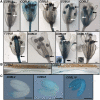Combining expression and comparative evolutionary analysis. The COBRA gene family
- PMID: 17098858
- PMCID: PMC1761980
- DOI: 10.1104/pp.106.087262
Combining expression and comparative evolutionary analysis. The COBRA gene family
Abstract
Plant cell shape is achieved through a combination of oriented cell division and cell expansion and is defined by the cell wall. One of the genes identified to influence cell expansion in the Arabidopsis (Arabidopsis thaliana) root is the COBRA (COB) gene that belongs to a multigene family. Three members of the AtCOB gene family have been shown to play a role in specific types of cell expansion or cell wall biosynthesis. Functional orthologs of one of these genes have been identified in maize (Zea mays) and rice (Oryza sativa; Schindelman et al., 2001; Li et al., 2003; Brown et al., 2005; Persson et al., 2005; Ching et al., 2006; Jones et al., 2006). We present the maize counterpart of the COB gene family and the COB gene superfamily phylogeny. Most of the genes belong to a family with two main clades as previously identified by analysis of the Arabidopsis family alone. Within these clades, however, clear differences between monocot and eudicot family members exist, and these are analyzed in the context of Type I and Type II cell walls in eudicots and monocots. In addition to changes at the sequence level, gene regulation of this family in a eudicot, Arabidopsis, and a monocot, maize, is also characterized. Gene expression is analyzed in a multivariate approach, using data from a number of sources, including massively parallel signature sequencing libraries, transcriptional reporter fusions, and microarray data. This analysis has revealed that the expression of Arabidopsis and maize COB gene family members is highly developmentally and spatially regulated at the tissue and cell type-specific level, that gene superfamily members show overlapping and unique expression patterns, and that only a subset of gene superfamily members act in response to environmental stimuli. Regulation of expression of the Arabidopsis COB gene family members has highly diversified in comparison to that of the maize COB gene superfamily members. We also identify BRITTLE STALK 2-LIKE 3 as a putative ortholog of AtCOB.
Figures








References
-
- Appenzeller L, Doblin MS, Barreiro R, Wang H, Niu X, Kollipara K, Carrigan L, Tomes D, Chapman M, Dhugga KS (2004) Cellulose synthesis in maize: isolation and expression analysis of the cellulose synthase (CesA) gene family. Cellulose 11 287–289
-
- Benfey PN, Linstead PJ, Roberts K, Schiefelbein JW, Hauser MT, Aeschabacher RA (1993) Root development in Arabidopsis: four mutants with dramatically altered root morphogenesis. Development 119 57–70 - PubMed
-
- Brenner S, Johnson M, Bridgham J, Golda G, Lloyd DH, Johnson D, Luo S, McCurdy S, Foy M, Ewan M, et al (2000) Gene expression analysis by massively parallel signature sequencing (MPSS) on microbead arrays. Nat Biotechnol 18 630–634 - PubMed
Publication types
MeSH terms
Substances
Associated data
- Actions
- Actions
- Actions
- Actions
- Actions
- Actions
- Actions
- Actions
- Actions
LinkOut - more resources
Full Text Sources
Other Literature Sources
Molecular Biology Databases

